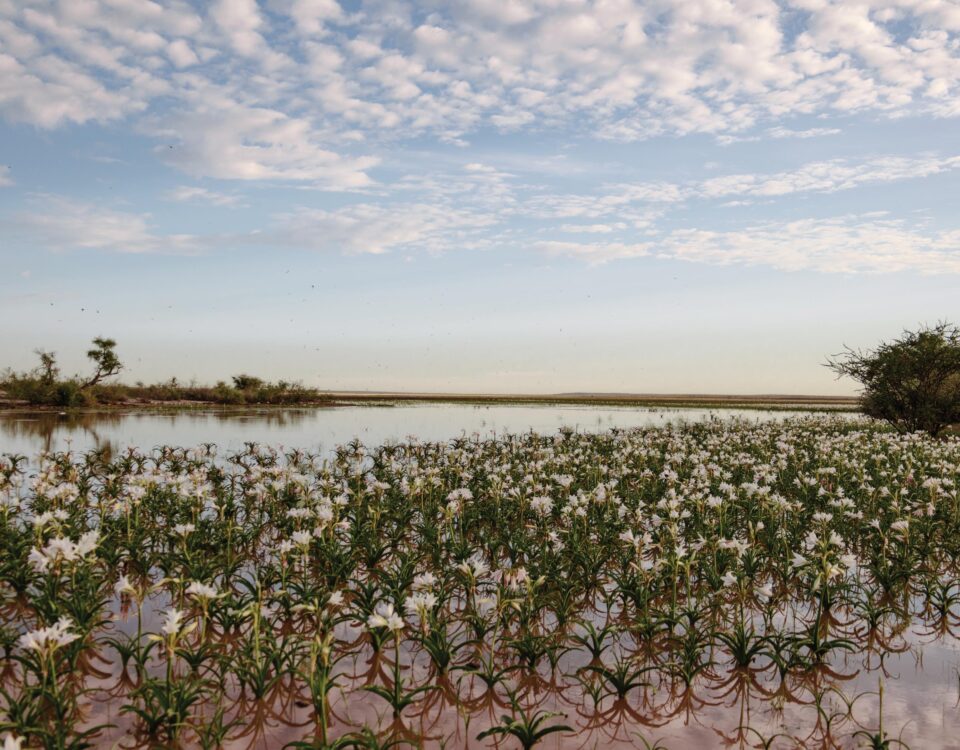Springbok Atlas announced new business model
June 20, 2012Where have all the fairies gone?
June 20, 2012The Desert Research Foundation of Namibia (DRFN), an NGO based in Windhoek, has a long-standing tradition of promoting sustainable development through wise resource management. Through one of their most successful endeavours, the Summer Desertification Programme, the DRFN is helping Namibian tertiary students gain valuable field and scientific skills. Em Westergaard, a volunteer at the DRFN, reports on the status of indigenous fruit trees that grow in the northern parts of Namibia.
The Summer Desertification Programme (SDP), which completed its eleventh year in 2003, is a research-training course, funded by Sida, aimed at enhancing environmental problem-solving abilities amongst Namibian students. All Namibians enrolled in or recently graduated from Namibian tertiary institutions are eligible to apply.
The most recent SDP, completed in February 2003, focused on the role of indigenous fruit trees in the north-central regions of Namibia. The two-month project, identified by the DRFN, Centre for Research Africa Action (CRIAA), and the Directorate of Forestry, sought to identify the potential for alternatives to enhance local livelihoods.
Fourteen students participated, drawn from the Polytechnic of Namibia, the University of Namibia, Ogongo Agricultural College and Neudamm Agricultural College. The course began with a week of training in Windhoek, covering topics including the hydrology of the areas in which the study would take place, the biology of fruit trees, soil composition and geomorphology. The students also learned technical skills, such as how to plan research projects, how to use GPS and GIS systems and how to conduct interviews. After that, the course participants spent time in Okahao and Ondobe in the Omusati and Ohangwena regions of northern Namibia.
With support from the Directorate of Forestry and the Farming Systems Research and Extension of the Ministry of Agriculture, and most importantly with input from local farmers, the team investigated the relationships among indigenous fruit trees, farming practices and the landscape where they grow. To achieve this, some measured the size of the trees and recorded where they grew and dug holes to determine the soil layers present, while others talked with the farmers about how they managed and utilised the fruits and trees. They conducted interviews on over 40 farms and measured over 2 500 trees. After completion of the fieldwork, they returned to the Gobabeb Training and Research Centre to work on data analysis and to write up their results.
Results show that individual farmers are in control of fruit-tree populations in northern Namibia. Indigenous fruit trees such as marula and palm are highly dependent on farmers for establishment and survival. The lack of fruit trees outside of farms supports this finding. Individual farmers also decide whether to cut down or retain fruit trees in their farms and they often plant, protect and fertilise young trees to encourage growth. Most new farms do not have fruit trees, indicating that people do not choose land specifically because fruit trees are present on the land, as some may have believed. Instead, farmers encourage fruit tree establishment and growth once they have settled.
Participants also found that farmers value fruit trees for the products that can be made from the fruits, such as oil or juice. Many of these homemade products supplement household food supplies, and surpluses of the products can be sold at local markets, providing supplementary income. Some fruits are already the focus of grass-roots marketing co-operatives, such as the marula co-operative project. Participants found that other fruits lacking established markets might benefit from similar marketing co-operatives.
Feedback to the farmers directly, as well as to extension services, is a key goal of the SDP. As in other years of the project, the students’ findings are of interest to farmers, decision-makers and scientists, and part of the training is to develop communications appropriate to each of these groups. Participants presented their results and recommendations to invited guests at the Information Weekend, held at the Gobabeb Centre on February 1 & 2. Feedback has also been presented to the communities in the north which participated in the study. Results and recommendations will soon be published in an occasional paper of the DRFN.
The SDP’s main objective is to contribute towards sustainable use of Namibia’s natural resources through appropriate environmental research training with an emphasis on research approaches, critical thinking and problem solving. The following objectives have been identified and refined by students and staff of SDP courses over the past several years:
• participants understand re-search and have the necessary skills to do it;
• participants can plan and implement a project independently;
• participants show a positive attitude toward learning, re-search and team work;
• participants apply research as a tool for environmental problem solving;
• participants have a clearer orientation about personal/ career development;
• the course is planned, implemented and documented in a participatory manner; and
• results of the course are reported orally in a professional manner to an appropriate, selected audience.
Although the primary objectives of the programme emphasise training for participants, the topics of the course have always been selected to reflect current environmental issues in Namibia. In some years the topics have been controversial, such as the SDP 6 investigation of the impact of illegal fencing in eastern Oshikoto.
The SDP has over 120 alumni, many of whom now play leading roles in Namibia’s public and private sectors. Participants have found the programme to be rewarding and enjoyable, and that the skills gained in the course have been well worth the effort.
This article appeared in the 2003/4 edition of Conservation and the Environment in Namibia.

